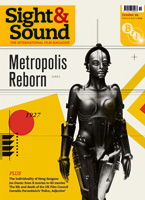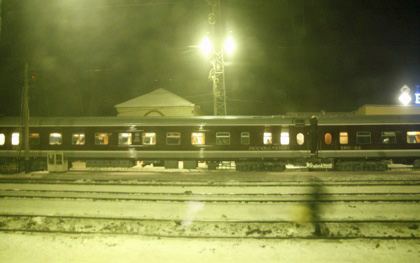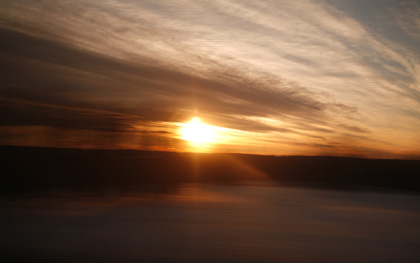Primary navigation


A journey into both the snowy wastes of Siberia and the fractured mind of its grieving narrator, Sarah Turner’s hypnotic ‘Perestroika’ is an immersive excursion into “extreme psychogeography”, says Chris Darke
If, in art, humanity is able to confront its deepest fears while holding them at bay through representation, what forms will artists turn to in the light of global warming? While the dystopian mode is the most obvious narrative form available, it requires an imaginative leap into a time after the worst has happened. The existential fact of living in the midst of climate change (and being responsible for it) calls for other modes of artistic expression. One can find such expression taking shape, perhaps, in a renewed attention to landscape – as witness the recent renaissance of British nature writing, which at the same time brings home the local effects of a global crisis, here and now.
In film, too, it may be similarly marginal forms that prove most germane. The ‘landscape film’ is a hardy sub-genre of British experimental cinema, from Chris Welsby’s elemental 1970s nature studies, via Derek Jarman’s The Garden (1990) – a record of his own little acre in the shadow of Dungeness nuclear power station – to the contemporary work of Peter Todd and Emily Richardson. In her remarkable film Perestroika, the British artist-film-maker Sarah Turner reinvents the genre for the present day: the ‘landscape film’ under the sign of extinction. The terrain covered is not British but Russian, more specifically Soviet and post-Soviet. Perestroika consists largely of footage shot on two train journeys 20 years apart from Moscow to Lake Baikal in Siberia, the first between 1987 and 1988 and the second between 2007 and 2008.
Cinema steamed into modern consciousness with the Lumière brothers’ L’Arrivée d’un train à La Ciotat (1897), and train and film have ever since shared a kinship as means of literal and virtual mechanical transport. The amalgam of ‘landscape film’ and ‘train movie’ gives Perestroika its visual form and structure, the landscape unwinding outside the window like film passing through a camera, and Turner emphasises the film-train association through the clicking of a camera shutter to evoke a locomotive rhythm. Over time, the effect is hypnotic and deeply immersive, the viewer becoming the film’s passenger, as it were, observing snowscapes, sunbursts and ravaged industrial landscapes through the window, eavesdropping throughout on a mind in meltdown.
While a number of British artist-film-makers such as Steve McQueen and Sam Taylor-Wood have made high-profile forays into feature film-making in recent years, Turner’s work sets her apart from the YBA alumni. Having studied at Central Saint Martins and the Slade art schools in the 1980s, she has been a film-maker for 20 years, and has less in common with the commercial art world than with the experimental tradition formerly associated with the London Film-Makers’ Co-op. Certain aesthetic features of this tradition are present in Perestroika, among them an interest in formalist rigour, whereby a single structural idea is pushed to its limits – in this case “sticking the camera out the window”, as Turner self-deprecatingly puts it. The technological process of recording sounds and images is foregrounded as part of what the film-maker questions as the “fixing” and “framing” inherent in storytelling. However, none of this comes across as dusted-down modernism. Having fully absorbed the lessons of her elected tradition, Turner puts them to work to worry away at what it means tell a story about oneself and the world.

Perestroika means ‘reconstruction’ and Turner’s film is both a literal re-enactment of a voyage undertaken by the film-maker in her twenties, and a heart’s journey in winter to the Siberian location where a close friend who accompanied her on the earlier trek later died in a traffic accident. Upon these autobiographical facts Turner builds a first-person narration that succeeds in drawing the viewer into her personal story, but also opens out into other modes through a series of real-time, private recordings addressed to a shifting, multivalent ‘you’, who is both her travelling companion and the viewer. We become intimately involved with this voice, its breathy near-whisper evoking the confidences and confessions of pillow talk – recording and observing the landscape, meditating on the status of the image, speculating about the other passengers, complaining about the heat in the cabin and lack of sleep, as she gradually enters a state of visionary delirium.
To describe Perestroika as an ‘experimental feature’ doesn’t do justice to its unclassifiable nature, both as a work and a viewing experience. In its travelogue-diary-essay form it has something in common with Chris Petit’s recent Content, but whereas Petit creates an ambient, driver’s-seat experience for the viewer, Turner cumulatively generates an intense, enveloping psychic climate that we inhabit physically, and which demands to be experienced in the cinema for its full effect to be felt. And while both works are psychogeographical, Turner’s version might be called ‘extreme psychogeography’, touching on the ‘beauty and terror’ in nature that informed Rilke’s idea of the sublime, which finds a focus in the film’s ecological concerns.
These manifest themselves both objectively and subjectively, in the images and the narrator’s thoughts alike. The critic Garrett Stewart has coined the term ‘cosmic zoom’ to describe a shot in which the camera appears to plummet from a view of Earth from space to light upon a terrestrial detail. Turner’s dominant technique could be called the ‘cosmic track’, in which landscape opens out to evoke the Earth through the associations of the narrator’s increasingly anguished reveries. The video footage Turner shot in the 1980s documents a snow-covered Siberian landscape, whereas in the more recent high-definition images the snow has thinned and, as the narrator observes incredulously, wheat is being harvested in winter. By the time the journey reaches Baikal, the deepest lake in the world and the zero-point of Siberia’s status as a weathervane of global warming, landscape and mind, physical and psychic spaces have fused. It is here that Turner pulls off the film’s coup de grâce, as her narrator turns into a crazed seer for whom the images we watch are full of ominous portents: steam rising from the water is smoke, tourists taking holiday snaps are dancers on a volcano and, in an apocalyptic vision, Baikal becomes a lake of fire awaiting the final sunset. And we realise that, throughout the journey, we have been passengers on a ghost train, a symbol of modernity haunted not merely by the past but by the idea of its own foreshortened future.
One person’s ‘visionary epic’ can be another’s self-indulgent folly, and some may find Turner’s film closer to the latter than the former. The inherent challenge of moving from an account of grief engendered by personal loss to a pre-emptive mourning for the human species is a major gamble (not only in terms of tone but ethically, too), but Turner pulls it off. The ambition on display here is laudable in itself, but what really distinguishes Perestroika is its search for a form to address the way the mind baulks at the idea of extinction, reflexively seeking the solace of disavowal and avidly misrecognising disaster as normality. As physically immersive as anything you’re likely to see at a 3D multiplex, Perestroika sets its coolly minimalist structure against a visceral emotional tone to produce a work unlike any other in current British cinema.
Sarah Turner talks about the genesis of ‘Perestroika’ on page 47 of the October 2010 issue of ‘Sight & Sound’
The tracks of time: Sarah Turner talks to Sophie Mayer (online, August 2010)
The deathly hallows: Artist Mat Collishaw on Armenian shrines, YouTube sheep sacrifices and his homage to the strange world of Sergei Parajanov (online, March 2010)
Grey area: Mark Fisher is mesmerised by Chris Petit’s documentary Content, an ‘informal coda’ to his 1979 film Radio On (March 2010)
Family photos: Sukhdev Sandhu revels in John Akomfrah’s Mnemosyne cine-essays on migration and memory (February 2010)